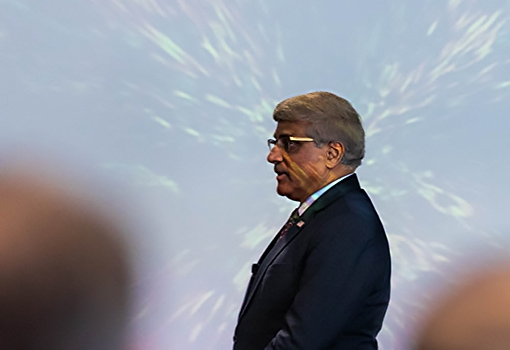National Science Foundation (NSF) Director Sethuraman Panchanathan paid a visit to UC Santa Barbara last week, touring facilities, talking to researchers, and sharing a vision for the future of science and science education in the United States.
“What are those things that we need to emphasize and build as we are thinking about the next decade,” he said, “and maybe even a few decades into the future?” Speaking to an audience at the Engineering Sciences Building after a morning spent seeing NSF-supported research in progress, Panchanathan outlined the role of the 73-year-old organization in the progress and accomplishments of science in the country. Established in 1950 by the United States Congress, the independent federal agency achieves its goals of promoting the progress of science, advancing national health, prosperity and welfare and securing national defense primarily by funding research.
UC Santa Barbara is among the many institutions that receive NSF support — NSF-sponsored grants constitute 42 percent of UCSB’s direct federal funding. Longstanding projects, such as the Santa Barbara Coastal (SBC) and the Moorea Coral Reef (MCR) Long-Term Ecological Research sites are funded by the NSF. Initiatives of the past few years, such as the BioPACIFIC Materials Innovation Platform and the AI Institute for Agent-based Cyber Threat Intelligence and Operation (ACTION), are also ambitious projects based at UCSB and supported by the NSF. NSF funding also recently awared the UCSB Materials Research Laboratory its seventh consecutive six-year grant. The agency’s early career awards, meanwhile, fund promising scientists at the first stages of their research careers.
The country is at a defining moment, Panchanathan said in his lecture, titled “Innovation Anywhere, Opportunities Everywhere.”

National Science Foundation Director Sethuraman Pachanathan.
